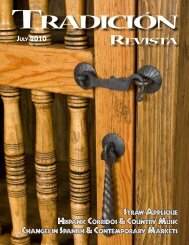tradicion revista fall 2012 - LPD Press & Rio Grande Books
tradicion revista fall 2012 - LPD Press & Rio Grande Books
tradicion revista fall 2012 - LPD Press & Rio Grande Books
Create successful ePaper yourself
Turn your PDF publications into a flip-book with our unique Google optimized e-Paper software.
men suffered from varying degrees<br />
of frostbite, and Juan Lueras lost<br />
two fingers of his left hand. In another<br />
action, 140 of the men suffered<br />
frostbite of the hand and feet,<br />
while one lost an ear and three toes.<br />
The hardships endured by the<br />
citizen militia was exceeded only by<br />
the suffering of the Navajo. In addition<br />
to the Navajo killed and captured,<br />
Governor Pérez reported he<br />
had dispersed numerous rancherías,<br />
depriving them of shelter and exposing<br />
them to the extreme weather.<br />
He felt that more Navajo had<br />
died as a result of this subsequent<br />
exposure than had been casualties<br />
during the armed encounters of the<br />
campaign itself. 2<br />
The governor concluded that although<br />
the campaign had failed to<br />
completely defeat the Navajo and<br />
eliminate them as a threat to frontier<br />
settlements, their efforts had<br />
partially succeeded. He noted that<br />
two days after arriving in Santa Fe,<br />
four Navajo delegates came into the<br />
capitol seeking peace negotiations.<br />
If these had succeeded in achieving<br />
even a short respite of hostilities,<br />
the suffering of both sides during<br />
the expeditions of 1836-37 might<br />
not have been in vain.<br />
But peace was not forthcoming.<br />
Sporadic raiding continued<br />
through the winter and spring of<br />
1837. However, just as Pérez contemplated<br />
another concerted campaign<br />
against the Navajo, New Mexico<br />
was thrown into the turmoil of<br />
the Revolt of 1837 in which Pérez<br />
and a number of officials of his administration<br />
were killed. It is possible<br />
that the physical and financial<br />
hardships imposed on New Mexi-<br />
98<br />
co’s citizen soldiers by the preceding<br />
campaigns were a significant factor<br />
in the opposition that developed<br />
against the Pérez administration in<br />
the spring of 1837.<br />
It was not until late summer<br />
1838, following Pérez’s demise and<br />
the end of the Revolt of 1837 that<br />
New Mexico was able to muster the<br />
energy and resources to respond<br />
to the Navajo raids that continued<br />
throughout 1837 and 1838. In addition<br />
to the militia, Governor Manuel<br />
Armijo could now count on<br />
the reinforcements provided by the<br />
Vera Cruz squadron that had been<br />
sent to New Mexico to assist in suppression<br />
of the 1837 insurrection.<br />
A total of 978 men, including 130<br />
soldiers of the Santa Fe presidio and<br />
Vera Cruz squadrons, left Jémez on<br />
or about 13 September. For nearly<br />
This essay is excerpted from Sunshine and<br />
Shadows in New Mexico’s Past: The<br />
Spanish Colonial & Mexican Periods<br />
1540-1848, published in collaboration with<br />
the Historical Society of New Mexico. The<br />
book can be ordered from <strong>Rio</strong> <strong>Grande</strong> <strong>Books</strong><br />
or online at Amazon.com.<br />
three weeks, these forces conducted<br />
operations south to the Gila, where<br />
they concluded the campaign with<br />
a pitched battle with the Navajo and<br />
some allied Apache. 3<br />
Governor Armijo’s memorandum<br />
of 6 November 1838 ordered<br />
the following statement be inserted<br />
into the ojas de servicio, or service<br />
records, of the officers and men who<br />
participated in the recently concluded<br />
Navajo campaign. The statement<br />
effectively provides an official<br />
summary of what the campaign accomplished.<br />
Each entry would note<br />
the particular officer or soldier had<br />
participated in the campaign that:<br />
during the months of September<br />
and October of<br />
1838, achieved the death of<br />
seventy-eight warriors, imprisonment<br />
of fifty-six individuals<br />
of both sexes, the<br />
rescue of one of our captives,<br />
capture of 226 horses<br />
and mules (vestias), 2,060<br />
sheep, 160 gamusas, six serapes,<br />
all their personal property<br />
as well as destroyed or<br />
captured 1,600 costales of<br />
corn. 4<br />
Once again, the campaign<br />
brought about no lasting respite<br />
from Navajo raids and by early December<br />
1838, another campaign<br />
was being organized. On 9 December<br />
expedition commander Pedro<br />
León Luján departed from Santo<br />
Tomás de Abiquiú with fourteen<br />
soldiers of the Santa Fe presidio and<br />
248 militia from the northern New<br />
Mexico communities of Abiquiú,<br />
Santa Cruz de la Cañada, Chama,<br />
Taos, Ojo Caliente, San Juan, San<br />
Yldefonso, Trampas and Rito Colorado.<br />
Luján’s journal of the cam-<br />
TRADICIÓN October <strong>2012</strong>




